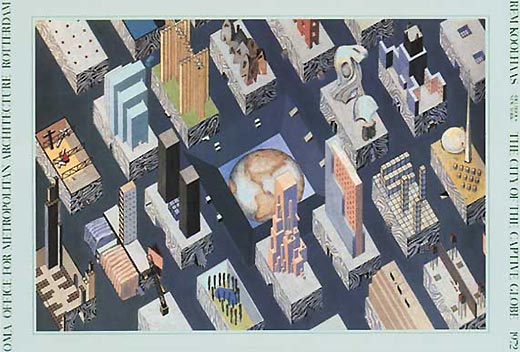
Product Dimensions: 100 x 68,7 cm
The City of the Captive Globe is a rendering of Rem Koolhaas's intuitive approximation of the architecture of Manhattan. This drawing, according to Koolhaas, celebrates Manhattan's "culture of congestion," presenting a relentless grid as Manhattan's overriding characteristic.
Within this scheme, each city block is designated to embody a different value or philosophy, among these are many avant-garde movements previously thought of as incompatible. Each block, which is itself a city, is surmounted by a structure that represents its function or identity, for example, El Lissitzky's Lenin's Stand, Le Corbusier's Plan Voisin, or Wallace Harrison's Trylon and Perisphere for the 1939 New York World's Fair. Koolhaas's metaphor proposes an urban model in which unity accommodates heterogeneity.

Product Dimensions: 100 x 68,7 cm
The City of the Captive Globe is a rendering of Rem Koolhaas's intuitive approximation of the architecture of Manhattan. This drawing, according to Koolhaas, celebrates Manhattan's "culture of congestion," presenting a relentless grid as Manhattan's overriding characteristic.
Within this scheme, each city block is designated to embody a different value or philosophy, among these are many avant-garde movements previously thought of as incompatible. Each block, which is itself a city, is surmounted by a structure that represents its function or identity, for example, El Lissitzky's Lenin's Stand, Le Corbusier's Plan Voisin, or Wallace Harrison's Trylon and Perisphere for the 1939 New York World's Fair. Koolhaas's metaphor proposes an urban model in which unity accommodates heterogeneity.